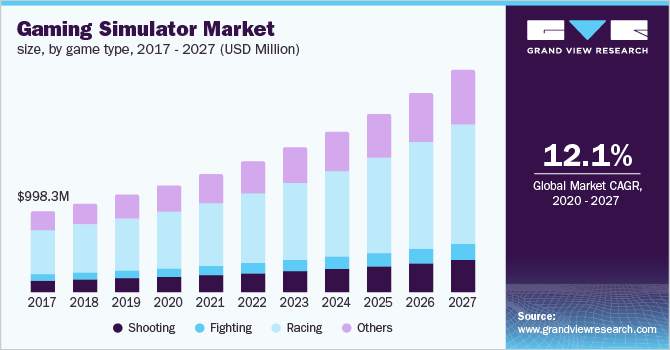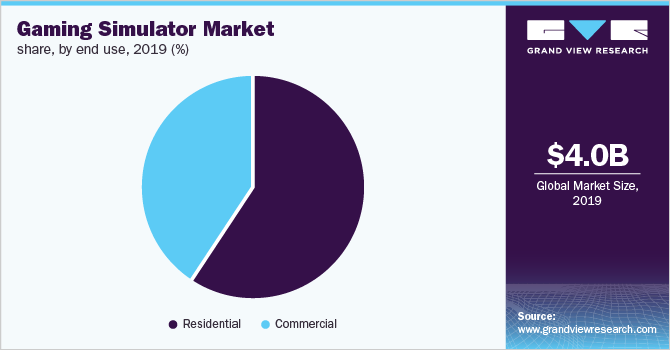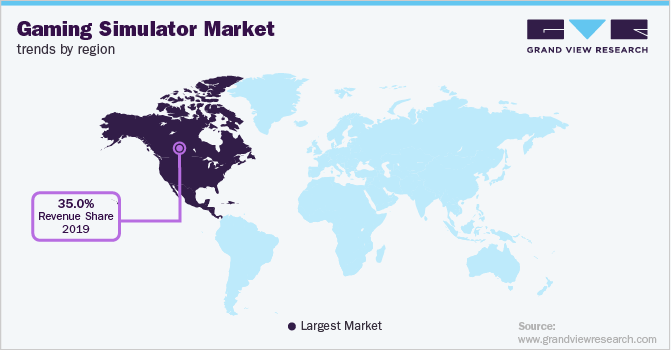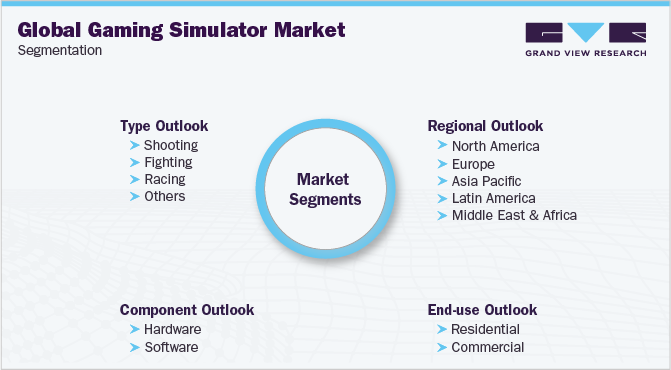
Gaming Simulator Market Size, Share & Trends Analysis Report By Component (Hardware, Software), By Game Type (Racing, Shooting), By End Use, By Region, And Segment Forecasts, 2020 - 2027
- Report ID: GVR-4-68039-227-3
- Number of Pages: 120
- Format: Electronic (PDF)
- Historical Range: 2016 - 2018
- Industry:Technology
Report Overview
The global gaming simulator market size to be valued at USD 9.99 billion by 2027 and is expected to grow at a compound annual growth rate (CAGR) of 12.1% during the forecast period. Initiatives being pursued by the market players to implement virtual reality to ensure real-life gaming experiences for gamers are expected to drive the market expansion. The growing adoption of gaming simulators for training and analysis in various industries and industry verticals is also expected to contribute to market growth. The use of gaming simulators as potential stress busters also bodes well for the growth.

The demand for gaming simulators is growing as gamers are increasingly preferring immersive and realistic games. Gaming simulators hold the potential to cater to these changing preferences of gamers. At the same time, new platforms are also being launched to introduce new and innovative games. This is prompting the industry players to develop advanced gaming simulators. For instance, in March 2019, Next Level Racing launched F-GT Lite, a portable racing cockpit that offers real-life Formula or GT racing experience.
Continued implementation of the latest technologies, including Virtual Reality (VR), in gaming simulators to offer real-life gaming experiences is anticipated to open new opportunities for the market players over the forecast period. Having realized that the young generation remains keen on trying out advanced games featuring rotating platforms and 360-degree cameras, vendors have started offering portable gaming setups. For instance, in September 2017, Roto VR Ltd. launched Roto VR Chair at the VR Summit convened in Seoul, South Korea. Roto VR Chair happens to be a motorized chair that can auto-rotate to facilitate 360-degree viewing.
The number of gaming zones offering a better gaming experience using gaming simulators is also growing. At the same time, several e-sports championships being organized in different parts of the world are also attracting gamers. Market players are responding to the situation by providing innovative gaming simulators for gaming zones as well as for e-sports championships. For instance, in September 2019, Next Level Racing provided 20 units of GTultimate cockpits for the Toyota Velocity Esports Championship convened in Malaysia. The continued rollout of high-speed internet networks and the rising popularity of network sharing and cloud computing are also playing a crucial role in driving the demand for gaming simulators.
However, the high prices of gaming simulators are anticipated to restrain the growth to a certain extent. Manufacturers of gaming simulators typically rely on third-party component providers for the supply of sensors and micro-controllers and third-party distributors and sellers for offering their products across the globe. At this juncture, any interruption or shortage in the supply of components, inability to procure components from alternate sources at affordable prices, disruptions in the operations of distributors and sellers, and disagreements with the distributors and sellers over the business terms can potentially challenge the growth of the market. The COVID-19 pandemic is taking its toll on the manufacturing and supply of gaming simulators as manufacturing facilities are shut due to the lockdowns being enforced in various parts of the world to arrest the spread of the disease. All these factors are expected to restrain the growth of the market over the forecast period.
Gaming Simulator Market Trends
Drivers
The increasing acceptance of 360 cameras for taking 360 VR photos without the use of expensive dedicated cameras has increased remarkably. As VR headsets for gaming have become more popular and the COVID-19 pandemic have limited travel options, the device facilitated the easy creation of virtual tours of tourist destinations. However, it greatly contributes to the growth. In addition, different industries use 360⁰VR photography to teach interns in a real-world workshop environment, and such applications of these devices are driving the growth.
游乐场、主题公园和游戏中心使用game simulators to provide end-users with real-world gaming experiences, thus, providing market-friendly solutions at low cost. According to a recent 2020 survey, more than 60% of end-users were interested in attending virtual concerts. Thus, an increase in the number of such developments is expected to boost the growth during the forecast period.
Moreover, amusement parks and others have invested in in-game simulators and VR to provide a better experience for gamers. This increasing adoption of VR is driving the gaming simulation market, and is boosting businesses that have lost viewers due to the COVID-19 crisis. Thus, all these factors are anticipated to act as drivers for the growth of the global market.
Restraints
Some studies suggest that hackers use famous digital reality VR headsets with constructed movement sensors. This is done to add subtle and speech-related facial dynamics to receive sensitive data that are communicated through voice commands, along with getting hold of credit scores, card records, and passwords. Thus, privacy and security concerns associated with these activities are hampering the growth of this market. Moreover, the high cost of VR headsets is another restraining factor that is negatively impacting the market growth.
Opportunities
Adoption of cloud computing and AI for higher-level gaming, upward push in collaboration among enjoyment enterprise, and gaming simulator corporations throughout the globe are anticipated to provide remunerative possibilities for the growth of the market during the forecast period.
Component Insights
硬件部分主要市场在2019年with a revenue share of over 55%. Hardware components play a vital role in improving the gaming experience. The growing popularity of virtual reality headsets, which help in improving the gaming experience, is expected to encourage industry players to develop advanced gaming simulator hardware. Based on components, the market has been segmented into hardware and software.
Gaming simulator hardware manufacturers are investing aggressively in advertising and marketing to promote their gaming simulators and components. These marketing campaigns, which allow the companies to create awareness about hardware components among users, are expected to contribute to the growth of the hardware segment over the forecast period. Market players are particularly focusing on developing advanced and cost-effective hardware components that can help in improving the gaming experience. For instance, in January 2020, Logitech launched Logitech G29, a racing wheel accessory that can enhance the racing game experience.
Game Type Insights
The racing segment dominated the market with a share of over 55% in 2019. Rising adoption of virtual training solutions for racing drivers to improve their driving skills is anticipated to drive the demand for racing simulators over the forecast period. Advances in visualization through multi-screen displays and VR-enabled displays would also play a decisive role in driving the demand for racing simulators. Based on game type, the market has been further segmented into shooting, fighting, racing, and others.
The growing demand for lightweight and compact racing simulators and initiatives being pursued by manufacturers to respond favorably to the changing gamers’ preferences particularly bodes well for the growth of the racing segment over the forecast period. For instance, in January 2019, Arozzi North America launched a race driving simulator called Velocità Racing Simulator at the Consumer Electronics Show (CES) 2019. Velocità Racing Simulator is a compact and lightweight simulator featuring a steering wheel, gear shift, and pedals. It is compatible with any gaming chair.
End-use Insights
The residential segment dominated the market with a share of over 59% in 2019, as the popularity of gaming among individuals continued to increase. The growing demand for advanced gaming simulators for a better gaming experience is expected to drive the growth of the residential segment over the forecast period. The introduction of features such, as gesture-based gaming, and high-quality graphics to enhance the gaming experience are also expected to contribute to the growth of the residential segment. Based on end-use, the market has been further segmented into commercial and residential.

The commercial segment is anticipated to witness significant growth over the forecast period. While gaming hubs would play a crucial role in driving the demand for gaming simulators, the gaming championships being organized in various parts of the world are also expected to trigger the demand for gaming simulators and contribute to the growth of the commercial segment. Various sports event organizations are partnering with manufacturers of gaming simulators to offer immersive virtual practicing and playing experience to the gamers. For instance, in January 2020, PGA TOUR, Inc. announced a partnership with Full Swing Golf, a provider of residential and commercial golf simulators. The partnership envisages PGA TOUR, Inc. offering an off-course golf experience to the gamers through the golf simulator developed by Full Swing Golf.
Regional Insights
North America dominated the gaming simulators market in 2019 with a share of over 35%. North America is home to some of the major market players, such as D-BOX TECHNOLOGIES INC.; CXC Simulations; and Razer Inc.; among others. The introduction of racing platforms at various theaters in North America to support motorsports and e-sports is also anticipated to drive the demand for gaming simulators in the region. For instance, in April 2018, VRX partnered with NAGRA to develop the SIM racing program in theaters using the myCinema platform.

越来越多的电子竞技比赛的器官ized in North America is anticipated to drive the demand for gaming simulators in the region. For instance, in June 2019, VRX installed racing simulators at an e-sports hub called ESPORTS CENTRAL in Montreal, Canada. The growing popularity of online games and the availability of custom-made gaming simulators is further expected to propel the growth of the regional market. Changing consumer trends, such as the rising preference for simulator-based video games as compared to other entertainment platforms, also bodes well for the growth of the North American regional market.
Key Companies & Market Share Insights
Major market players are pursuing various initiatives, including new product development, mergers & acquisitions, and strategic partnerships and agreements, to cement their foothold in the market. For instance, in August 2019, Next Level Racing launched an affordable and high-quality Challenger Simulator Cockpit. The cockpit is used for racing and flight simulation. The cockpit is available for USD 349 in North America, EUR 349 in Europe, AUD 499 in the Asia Pacific, GBP 299 in the U.K.
Contract manufacturers are supporting market players in increasing their internal manufacturing capacity and overcoming the volatility in production volumes. A combination of in-house manufacturing and contract manufacturing is allowing market players to leverage economies of scale and effectively respond to the changing demand for gaming simulators. Market players are also investing aggressively in developing new and improved versions of gaming simulators to improve the gaming experience. For instance, Logitech invested USD 177.6 million in research & development in 2019 to develop advanced technologies and introduce new products.
Recent Developments
In March 2022, CXC Simulations launched a new gaming simulator called Motion Pro II. It makes use of a brand-new movement and simulator to manipulate the machine and refine the seat-of-the-pants feeling that has made it the maximum sought-after simulation machine in the world
In January 2022, D-BOX collaborated with RazerTM, the world's top gaming lifestyle brand, to create the first Razer gaming chair that incorporates D-high-fidelity BOX's haptic technology. The Las Vegas prototype project uses signals from games and a range of completely integrated entertainment channels to provide the best touch-sensory stimulation
Some prominent players in the global gaming simulators market include:
3D Perception
AeonSim
CKAS Mechatronics Pty Ltd.
CXC Simulations
D-BOX TECHNOLOGIES INC.
Eleetus
Hammacher Schlemmer & Company, Inc.
Play seat B.V.
RSEAT有限公司
Vesaro
Gaming Simulator Market Report Scope
Report Attribute |
Details |
Market size value in 2020 |
USD 4.49 billion |
Revenue forecast in 2027 |
USD 9.99 billion |
Growth rate |
CAGR of 12.1% from 2020 to 2027 |
Base year for estimation |
2019 |
Historical data |
2016 - 2018 |
Forecast period |
2020 - 2027 |
Quantitative units |
Revenue in USD million and CAGR from 2020 to 2027 |
Report coverage |
Revenue forecast, company ranking, competitive landscape, growth factors, and trends |
Segments covered |
Component, game type, end-use, and region |
Regional scope |
北美;欧洲;亚太地区;拉tin America; MEA |
Country scope |
U.S.; Canada; U.K.; Germany; China; India; Japan; Brazil |
Key companies profiled |
3D Perception; AeonSim; CKAS Mechatronics Pty Ltd.; CXC Simulations; D-BOX TECHNOLOGIES INC.; Eleetus; Hammacher Schlemmer & Company, Inc.; Play seat B.V.; RSEAT Ltd.; Vesaro |
Customization scope |
Free report customization (equivalent up to 8 analysts working days) with purchase. Addition or alteration to country, regional & segment scope. |
Pricing and purchase options |
Avail of customized purchase options to meet your exact research needs.Explore purchase options |
Global Gaming Simulator Market Segmentation
This report forecasts revenue growth at global, regional, and country levels and provides an analysis of the latest industry trends in each of the sub-segments from 2016 to 2027. For this study, Grand View Research has segmented the global gaming simulator market report based on component, game type, end-use, and region:

Component Outlook (Revenue, USD Million, 2016 - 2027)
Hardware
Software
Game Type Outlook (Revenue, USD Million, 2016 - 2027)
Shooting
Fighting
Racing
Others
End-use Outlook (Revenue, USD Million, 2016 - 2027)
Residential
Commercial
Regional Outlook (Revenue, USD Million, 2016 - 2027)
North America
U.S.
Canada
Europe
U.K.
Germany
Asia Pacific
China
India
Japan
拉tin America
Brazil
The Middle East & Africa (MEA)
Frequently Asked Questions About This Report
b.The global gaming simulator market size was estimated at USD 4.04 billion in 2019 and is expected to reach USD 4.49 billion in 2020.
b.The global gaming simulator market is expected to grow at a compound annual growth rate of 12.1% from 2020 to 2027 to reach USD 9.99 billion by 2027.
b.North America dominated the gaming simulator market with a share of 36% in 2019. This is attributable to the presence of key manufacturers of gaming simulators in the region.
b.Some key players operating in the gaming simulator market include 3D Perception; AeonSim; CKAS Mechatronics Pty Ltd.; CXC Simulations; D-BOX TECHNOLOGIES INC.; Eleetus; Hammacher Schlemmer & Company, Inc.; and Play seat B.V.
b.Key factors driving the gaming simulator market growth include gaming solution providers adopt virtual reality technology to enhance real-life gaming experiences and automobile industries are expected to adopt simulators to improve new model designs and performance.
We are committed towards customer satisfaction, and quality service.
"The quality of research they have done for us has been excellent."






